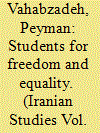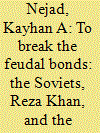| Srl | Item |
| 1 |
ID:
180019


|
|
|
|
|
| Summary/Abstract |
The emergence and rapid but short-lived presence of Students for Freedom and Equality (SFE; in Persian: Daneshjuyan-e Azadikhah va Barabaritalab or DAB) across major Iranian campuses and their fateful 4 December 2007 protest rally on the campus of the University of Tehran speaks of the return of leftist student activism to Iranian campuses after almost two decades of absence or invisibility within the context of post-revolutionary Iran. SFE was an umbrella democratic organization: its activists came from a plurality of social and political backgrounds and adhered to diverse leftist ideas. But in the context of pro-Reform Movement student activism in Iranian post-secondary institutions in the late 1990s and in 2000s, for a short time the SFE tried to hegemonize student activism and challenge the various pro-government tendencies in university campuses. Before state repression forced the SFE out of operation in 2007, Students for Freedom and Equality brought to campuses candid discussions of social justice issues, critique of Iran’s neoliberal economic policies, and challenges to censorship and lack of freedom.
|
|
|
|
|
|
|
|
|
|
|
|
|
|
|
|
| 2 |
ID:
180026


|
|
|
|
|
| Summary/Abstract |
From 1921-25, the USSR normalized its relations with Iran, withdrawing support from the Soviet Socialist Republic of Iran in the northern province of Gilan (SSRI, 1920-21), and signing the Irano-Soviet Treaty of Friendship in February of 1921. Thus far, most scholarship has argued that material interests, and especially Soviet designs on Iranian oil, compelled their anti-revolutionist turn in Iran. This article, which draws upon original collections from the Archive of Foreign Policy of the Russian Federation (AVPRF) and others, argues that the defeat of the SSRI did not mark the final Soviet attempt to socialize Iran, but rather the first of several that recruited leftist parties, tribal actors, and even the Shi‘ite clerical establishment until 1923. Secondly, this article argues that the Soviets eventually threw their support behind Reza Khan not only because some senior policymakers believed that his modernizing authoritarianism would provide the preconditions for Iranian socialism, but also because of a growing hostility to the Iranian left, whose revolutionary designs the Soviets eventually deemed premature. These findings are supported by archival diplomatic reports and communiques, which the author employs to interrogate the knowledge production intended by the Soviets to justify their anti-revolutionist turn in Iran.
|
|
|
|
|
|
|
|
|
|
|
|
|
|
|
|